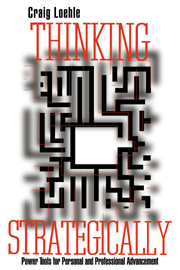Summary: The strategic thinker
Published online by Cambridge University Press: 24 September 2009
Summary
Strategic thinking is an overall technology for problem solving with the potential for increasing both the quantity and the quality of work in fields where creation of novel solutions is critical, for example design, invention, institutional innovation, research, software development, and engineering. It is based on an understanding of both outward processes (actions) and inner operations (cognition, attitudes). It takes particular care to be alert to the inherent flaws in all aspects of the problemsolving process, and builds in checks and balances against these flaws.
There are four factors involved in the successful development of an innovative creation: creative mental functioning, an understanding of the discovery process, an appreciation of the structure of multistep problems, and the utilization of reality checks. Creative mental functioning is necessary for one to be able to recognize problems, overcome intimidation by the status quo, overcome barriers to thought, and avoid stagnation. Various attitudes and work habits such as topic surfing and overcoming writer's block, contemplative walking and not becoming an expert, may allow one to increase innovative capacity and to recognize good ideas when they come along. Creative functioning alone, however, produces only bright ideas not finished products. Discovery is the next key step that represents the development of the germ of an innovative idea. The key point in the context of strategic thinking is the recognition that discoveries are almost always initially amorphous and in need of elaboration before they can be communicated, tested, or formally documented.
Information
- Type
- Chapter
- Information
- Thinking StrategicallyPower Tools for Personal and Professional Advancement, pp. 184 - 188Publisher: Cambridge University PressPrint publication year: 1996
